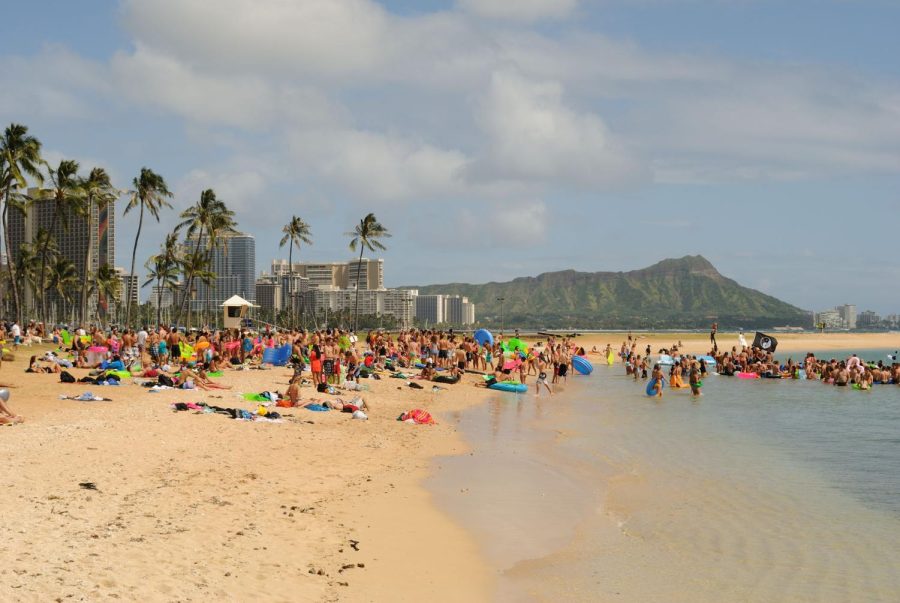What makes spring break, spring break?
Stigma, social pressures and socioeconomic implications
Some college students spend their spring break at the beach.
March 31, 2023
“What are you doing for spring break?” I was asked this question at least three times in one day in the months leading up to this eagerly anticipated week in March. My answer was always “I don’t know yet.” It seemed to me that there were so many possibilities, yet each came with its own set of limitations and, therefore, hesitations.
The questions circling my mind included: how would my strict, overprotective parents feel if I ventured off with my friends to the crowded beaches of Fort Lauderdale, Fla.? Could I even afford to take this trip? What’s so wrong with going home alone and doing nothing for a week? Once I realized that my friends and classmates held similar opinions, I decided to take a deep dive into what makes spring break, “spring break.”
Social Pressures
One of the many reasons I was hesitant to travel with my friends over spring break was fear of leaving someone out. I’m sure that many Wake Forest students can relate to this dilemma — we often socialize on campus in large groups, but when it’s time to plan a trip or an event with a limited head count, things become tricky. Almost everyone has been on either side of this situation at one time or another, either feeling guilty or hurt.
That’s the thing about not traveling over spring break — the FOMO (fear of missing out) is real. Many people I know have admitted to feeling pressure to travel with friends simply because of this reason. They were worried that their friends would have a little bit too much fun without them, making unique memories and becoming closer than ever before. The return to campus would be a painful one, with the unfortunate feeling of being on the outside.
Sometimes social pressure wins this battle, and sometimes it doesn’t. On one hand, if students would rather spend time at home with family or participating in other activities, they might fear being viewed as boring or lame. On the other hand, many students are judged as excessively rich and even “basic” when they travel to tropical or far-off locations. Regardless, at the end of the day, it’s up to each individual to choose how to spend their spring break and make the best of it. In an ideal world, there would be no labeling or judgment.
Socioeconomic Implications
Many students’ spring break plans are determined by their family’s income, as are many other things. In this way, there is another stereotype underlying the spring break stigma — that full-time students can afford a week-long, sunshine-and-alcohol-fueled vacation. I’m sure that this is the perception that many of us hold, or at least have held at some point in our lives.
Of course, we all know that at Wake Forest this may be the case for many students compared to other universities. Wake Forest students have a higher socioeconomic status than many other universities. If students can afford this, whether through their family’s money or even their own, then they should take advantage of the opportunity if they wish to do so. But this is not everyone’s socioeconomic situation. We need to do better in being grateful for what we have and making fewer assumptions about other people’s backgrounds. It’s important to be mindful of the economic inequality that exists at every university and how this relates to our individual spring breaks. Being mindful about socioeconomic status helps us recognize the amount of privilege that Wake Forest students inherently have, and this can easily be seen through the lens of those lavish spring break trips.
Stigma
Growing up, I remember my parents warning me about the stereotypical college spring break experience, most of which take place somewhere tropical. “Bad things happen” was the message they engraved into my brain. Fourteen-year-old me might as well have held up my right hand and swore that I’d stay away from Miami, Daytona Beach, Cancun or Punta Cana. Of course, the message of “bad things happen” doesn’t exactly translate to the minds of college students. Instead of gently pulling them away from the temptation of having a rowdy and wild spring break, it’s more of an aggressive shove forward.
Who and what created the spring break stigma? We all know there is a disconnect between our generation and our parents’ and grandparents’ generations’ ideas of “fun.” During the month of March, as their generations read the news headlines, phrases such as “brawl on the beach,” “mass overdose” and “Americans killed” jumped out at them.
Unfortunately, it’s true. Dangerous incidents and tragedies occur every year in many of these popular destinations. For example, officials at Panama City Beach have made more than 250 arrests in 2023 as of March 15 for disorderly conduct, driving under the influence, possession of narcotics and underage drinking. The list of misfortunes goes on: various diseases are spread, people cheat on their partners and many decisions are regretted.
While it may seem as though students are the ones primarily negatively affected here, there is another side to this problem. Residents of the most popular beach towns experience increased traffic, noise and litter during this time of year. The crowds overwhelm their local resources — transportation, restaurants and, of course, beaches.
Therefore, it’s not uncommon for our parents to look down on us with concern, fear and even disgust when it comes to this topic. In fact, it makes sense. The spring break stigma is a two-way street. Both the behavior of reckless college students and the distress of their families contribute to this week’s mark of shame. Is there any way to stop it? I don’t know. Most likely, this pattern will continue to cycle. Government authorities obviously play a large role in this cycle through laws and regulations. For example, the consumption of alcohol in parking lots and in vehicles, littering, and violence should continue to be prohibited. Travelers should see to it that they follow these rules to the best of their ability, and take precautions when necessary: protect your location, stick with your friends, and practice safe drinking. These efforts all contribute to keeping spring break fun, relaxing, and most importantly safe.














